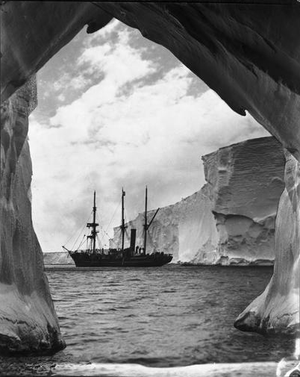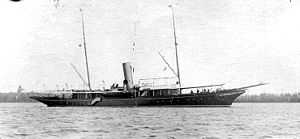Steam yacht

A steam yacht is a class of luxury or commercial yacht with primary or secondary steam propulsion in addition to the sails usually carried by yachts.
Origin of the name

The English steamboat entrepreneur George Dodd (1783–1827) used the term "steam yacht" on 16 May 1817[1] albeit in describing PS Thames, ex Duke of Argyle. She was one of the five passenger steamboats then under Dodd's direction, and his description was used in an effort to advertise how luxurious these vessels were-for the general public. Her service on the river had first been reported in a newspaper.[2] At that time, she had not been formally renamed, but was still sailing under the description "Thames steam yacht".
The history of the first three private steam yachts is as follows:
- Quentin Durward, wooden paddle steamer registered 10 June 1823 by builders Sime & Rankin, Leith,100'8" x 16'5" x 9'3", 78 tons. After being sold to R.Ogilvie & G.Crichton of Leith in 1823 and to the Leith & Dundee Steam Packet Co, Dundee in 1824,[3] she was sold on 12 June 1827 by the English millionaire Richard Thornton,to Kaptajnløtnant Lauritz Christensen, Copenhagen, who renamed her Dania. Since he first used her on pleasure tours on the Sound, this makes her the first ever private steam yacht[4]
- Endeavour, wooden paddle steamer registered 28 Jan.1828 by builders Rawlinson and Lyon, Lambeth, 75’6” x 12’ x 7’2”, 25 tons with a 20 HP Maudslay patent[5] oscillating engine with two cylinders 20in. dia. X 2 ft. stroke and registered to the eminent English engineer Henry Maudslay,[6] London on 21 February 1828, who used her as his private steam yacht. The eminent Scottish engineer James Nasmyth mentions a trip with her to Richmond.[7]
- Swift, wooden sailing smack built in 1803 at Bridport by Booles & Good, not registered. Unknown owners at Leith in 1804 - documents missing.[8] Converted to a paddle steamer, described as a steam yacht, and registered by T. West, H. Bellingham, E. H. Creasey and others of Brighton on 21 August 1822 at Shoreham-by-Sea, 106’5” x 23’1” x 10’8”, 143 tons. They ran her as a ferry boat between Brighton and Dieppe.[9][10]
She was sold to G. Crichton, R. Ogilvie & others in Leith in February 1824.[11] Crichton & Ogilvie were well-known managers.[12] She was sold to H. Templer in London in September 1827[13] and finally to Turkey in October 1828 when she became the Sultan's steam yacht Surat,[14] later taken in to the Ottoman Navy as its first steam vessel.
Thomas Assheton Smith II was excluded from the Royal Yacht Club (RYC) for his championship of the steam yacht, eight of which he commissioned between 1830 and 1851.[15] In cooperation with the Scottish engineer Robert Napier, whose Govan, Glasgow yard built a number of them, Smith did much to improve the hull design of steam yachts.[16] After 1856, when the Royal Yacht Squadron (the Club became Squadron in 1833) removed their edict, steam yacht building really began to multiply.[17]
The term "Double Steam Yacht" refers to a type of mechanised fairground swing devised by the English fairground equipment engineer Frederick Savage.[18]
Types

The term "steam yacht" encompasses vessels of two distinct uses, but of similar design.
1. The first is a luxury yacht in the modern sense—a vessel owned privately and used for pleasure or non-commercial purposes. Steam yachts of this type came to prominence from the 1840s to the early-20th century in Europe. The first British royal yacht was Victoria & Albert of 1843. The first in the USA, Vanderbilt's steam yacht North Star, was from 1854: steam yachts were commissioned by wealthy individuals and often heads of state as extravagant symbols of wealth and/or power.[19] They were usually built with similar hull-lines to clipper ships, with an ornate bow structure and a low, smooth freeboard. Main propulsion usually came from one or two steam engines, later of compound type, or in even later, very large yachts, triple expansion or turbines. Steam yachts usually carried rigging for sails, originally as an auxiliary propulsion system, but later more for show and naval tradition. Private steam yachts were capable of long seagoing voyages, but their owners' needs and habits saw most stay near to the coast. Inland seas such as the Baltic and the Mediterranean were popular areas for using steam yachts.
Statistics show that Clydeside was the premier building area for steam yachts: 43 shipbuilding yards on Clydeside built 190 steam yachts between 1830 and 1935.[20]
Scotts Shipbuilding & Engineering Co Ltd of Greenock Scotland built 23 steam yachts between 1876 and 1904.[21]
2. Those of the second class of steam yacht were built for commercial use, but gained the 'yacht' title due to their size and design similarity with the private vessels and because they were not constructed to be mainly cargo- or passenger-carrying vessels, but as versatile, low-draft ships capable of working local coastal routes. This is closer to the original meaning of the word "yacht", coming from the Dutch term Jacht, describing a small, fast commercial vessel. The distinction between a commercial steam yacht and a coastal trading vessel is not a clear one, but the latter term usually implies a mainly cargo-carrying ship. Steam yachts were often run by Packet Companies operating regular, timetabled services between islands or coastal towns. Steam yachts were widely used in the whaling trade.
The light, fast design of a steam yacht was ideal for chasing whales, and the lack of a large amount of cargo space did not matter as whaling produced few bulky products. Commercial steam yachts were rarely as ornate or luxurious as their private counterparts, with simpler, more rugged lines and usually a more practical sailing rig. Steam yachts used in the whaling trade often had reinforced hulls to allow them to operate amongst the ice of frozen waters.
This meant that several whaling-yachts crossed the definition from commercial to private yacht in later life when they were bought for polar exploration work. Since these expeditions were, by and large, privately funded the ships used became, by definition, private steam yachts and many were registered with the 'SY' prefix used for such craft. The Aurora, Morning, Nimrod, Terra Nova and the Quest are all examples of commercial vessels that went on to become steam yachts used during the Heroic Age of Antarctic Exploration. It was common for expedition leaders to be members of a yacht club, so many of these ships were registered to a a civilian club and flew a club burgee (and a Blue Ensign in the case of British steam yachts). Ernest Shackleton's ship the Endurance and Roald Amundsen's Fram are unusual cases of vessels being purpose-built as an icebreaking private steam yacht. The Endurance was originally built for conducting tourist cruises of the Arctic, bringing her close to the definition of a yacht in the modern sense.
The Royal Navy used small numbers of steam yacht-type vessels from the Victorian era onwards to transport men and equipment in harbour, act as coastal escorts for larger ships and for training and exercises. A good example of this was the iron p.s. Fire Queen built for the entrepreneur Thomas Assheton Smith (II) (1776–1858), (his first of three Fire Queen's) by Robert Napier, Govan, Glasgow and launched on 27 July 1844, Napier Yard No 5, engine No 88.[22] She was bought by the British Admiralty in July 1847 for £5,000 for use as a tender; there is an illustration (incorrectly captioned) of her in that role.[23] She was sold on 4 August 1883 for £1,100 by the Admiralty to Castle the shipbreakers.[24] Fire Queen was replaced by the Admiralty by the former Steam yacht Candace, launched on 23 September 1881 by Ramage & Ferguson, Leith, bought by the Admiralty in 1882 and then duly renamed Fire Queen.[24]
_1889.jpg)
In the First World War vessels such as these and several requisitioned private yachts were used on anti-U-Boat patrols and for minesweeping. It became clear that the naval trawler was more suited to these kinds of tasks.
Steam yachts often used the ship prefix SY, but some were alternatively described as screw schooner, if they carried schooner rig. A fine example of the screw schooner is the 125 year old British Amazon, built at Southampton in 1885 from designs by the renowned Dixon Kemp and still in use in the USA after crossing the Atlantic in 2009, although Diesel-propelled since 1937. She was photographed on Columbus Day 2009 on a mooring near the Herreshoff Marine Museum in Bristol, Rhode Island.[25]
Examples
Aurora built by Alexander Stephen & Sons Ltd, Glasgow in 1876 (a former whaling-yacht turned Antarctic exploration vessel) is a notable example of the class, as are the Victorian era yachts used by European monarchs, such as the HMY Victoria and Albert III and the SMY Hohenzollern. One of the oldest steam yachts, and one of the few still surviving today, is the Kheideval Yacht, Mahroussa, which was built in 1865 and was maintained in seaworthy condition by the Egyptian government. The present (June 2012) situation has not been checked.
See also

| Wikimedia Commons has media related to Steam yachts. |
References
- ↑ Parliamentary Report of 24 June 1817, 29
- ↑ The Times. 8 July 1815.
- ↑ British National Archives BT107/406, Leith No. 19, BT107/408, Dundee No.31,
- ↑ Petersen, Holger Munchaus (1983). Danske dampskibe indtil 1870 (in Danish). Esbjerg: Fiskeri- og Søfartsmuseet, Saltvandsakvariet. p. 89. ISBN 13 978-87-87453-25-7 Check
|isbn=value (help). - ↑ British Patent No. 3050, 1807, "Steam Engines"
- ↑ The National Archives BT107/52, No. 55
- ↑ Nasmyth, James (1883). James Nasmyth, Engineer: An Autobiography. London: John Murray. p. not cited.
- ↑ Hawks, Fred, World Ship Society CD No. 2
- ↑ The National Archives, BT107/169, Shoreham No.15.
- ↑ Parliamentary Report 1822, page 201.
- ↑ BT107/408.
- ↑ Martine, John (1888). Reminiscences of the port and town of Leith. Edinburgh: John Martine. p. 4.
- ↑ "Piece reference BT 107/51—Registry of Shipping and Seamen: Transcripts and Transactions, Series I—London Foreign Trade—Ports: 277 - 503, No. 379". The Catalogue. The National Archives.
- ↑ "Piece reference BT 107/51—Registry of Shipping and Seamen: Transcripts and Transactions, Series I—London Foreign Trade—Ports: 277 - 503, No. 383". The Catalogue. The National Archives.
- ↑ Dawson, C (August 2006). "Thomas Assheton Smith's Steam Yachts". The Mariner's Mirror 92 (3).
- ↑ Eardley-Wilmot, Sir John E., ed. (1860). Reminiscences of the late Thomas Assheton Smith, Esq. London: John Murray. p. 55.
- ↑ Kemp, Dixon, Steam Yachts, RINA 24th Session, 15 March 1883
- ↑ "Fairground Sale Steams Ahead". BBC News online. 11 October 2002.
- ↑ Marine Engineering. Volume 4. Marine Publication Co. 1899. pp. 142–144.
- ↑ Clydesite Ships Database
- ↑ Two Centuries of Shipbuilding by the Scotts at Greenock. London: Scotts. 1906.
- ↑ World Ship Society Yard List No 169/5.
- ↑ Gardiner, Robert, ed. (1993). The Advent of Steam: The Merchant Steamship Before 1900. Conway's History of the Ship. London: Conway Maritime Press. p. 36. ISBN 0851776183.
- ↑ 24.0 24.1 Lyon, David; R (2004). The Sail and Steam Navy List: All the Ships of the Royal Navy, 1815-1889. London: Chatham Publishing. p. 286. ISBN 1861760329.
- ↑ http://coastalcafe.blogspot.com/2009/10/1885-british-screw-schooner-amazon-at.html[]